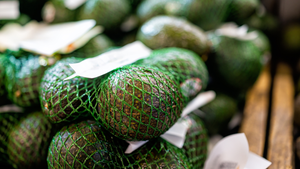PRODUCE DEPARTMENTS ARE URGED TO ADAPTPRODUCE DEPARTMENTS ARE URGED TO ADAPT
NEWARK, Del. -- Despite considerable growth in supermarket produce departments in recent years, the industry must continue to change the way it does business to increase demand, improve training and improve distribution.That is according to Bryan Silbermann, executive vice president of the Produce Marketing Association here, who was interviewed by SN as he prepared for the trade group's annual convention,
October 17, 1994
TONY SPLEEN
NEWARK, Del. -- Despite considerable growth in supermarket produce departments in recent years, the industry must continue to change the way it does business to increase demand, improve training and improve distribution.
That is according to Bryan Silbermann, executive vice president of the Produce Marketing Association here, who was interviewed by SN as he prepared for the trade group's annual convention, which begins Oct. 22 in San Antonio.
One of the most important issues facing the industry, Silbermann said, is the need to increase produce consumption. PMA's goal is to have Americans eating five servings per day by the year 2000. Consumption now stands at about 3.5 daily servings, he said.
Increasing consumption means marketing, and PMA is working to position itself as the leading national trade association helping the produce industry sell its products. The convention will reflect that, he said, with 30 educational sessions and workshops on marketing-related issues.
Several workshops at the convention, as well as association programs throughout the year, will focus on how retailers can use the 5 a Day for Better Health program to move more produce, Silbermann said. The program, aimed at boosting produce consumption, is jointly run by the Produce for Better Health Foundation and the National Cancer Institute, and operates out of PMA's headquarters here. PMA contributes $20,000 annually to help fund the program.
Training store-level personnel, a challenge for all perishables departments, is high on PMA's agenda this year, said Silbermann, who pointed out that misidentification of produce by clerks and cashiers is one of the leading causes of shrink.
Silbermann said PMA is also looking into providing more programs that can be used by individuals at store level or during group training sessions at a supermarket's headquarters. The association is also planning to provide more of its programs in both English and Spanish.
He said the association's training task force, made up of retailers and suppliers, met recently to start work on interactive computer training programs for produce clerks and supermarket cashiers. He said production of a program could start within the next six months.
Silbermann said the challenge is to make sure it doesn't outpace the capabilities of the industry.
"Right now we're looking at various options as well as how much supermarkets would be willing to pay for such programs," he said. "In 1987 we were looking at how many supermarkets had VCRs in their back rooms for training. Now in 1994 we're looking at how many supermarkets have PCs to run training programs."
Silbermann said another key priority for the trade group is improving the efficiency of the entire produce distribution system.
Industrywide use of standardized price look-up codes, developed to replace the plethora of different codes developed by individual retailers, will help add efficiency to the entire produce distribution chain. While many retailers have adopted the standardized codes and abandoned their own, more retailers need to get on board, he said.
The number of stores using standardized codes, he said, has more than doubled from 2,200 in 1993 to 5,000 this year.
He said that 45% of the top 100 supermarket chains are currently using standardized PLUs or are in the process of converting to them. Silbermann predicted that by the end of 1995, three-quarters of the top retailers will be using the standardized numbers.
A special workshop at the convention will update retailers on the acceptance to date and the challenges of converting to the new numbers.
PMA will also continue working with suppliers to encourage them to adopt the use of standard 48-inch by 40-inch, two-way pallets to help improve efficiencies, Silbermann said.
While statistics are limited on the number of suppliers currently using a standard pallet, he said, "major progress" has been made. He cited the grape, melon and strawberry industries as groups that have recently committed to shipping on a standard pallet.
About the Author
You May Also Like




